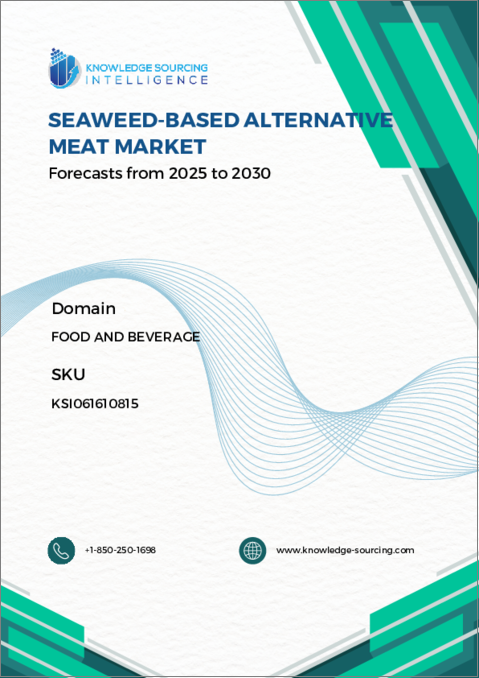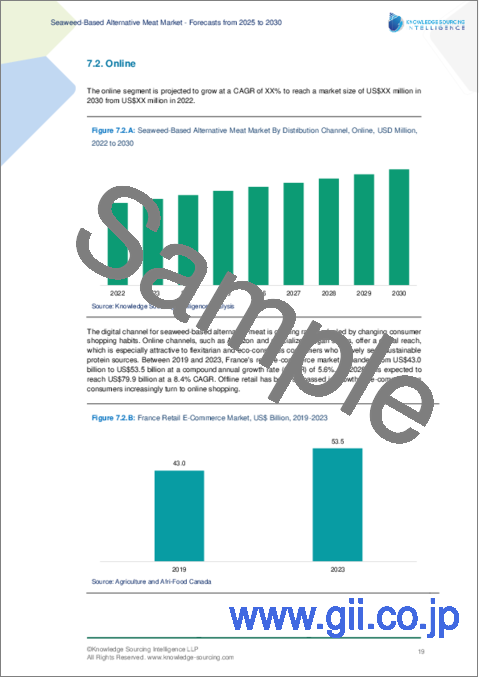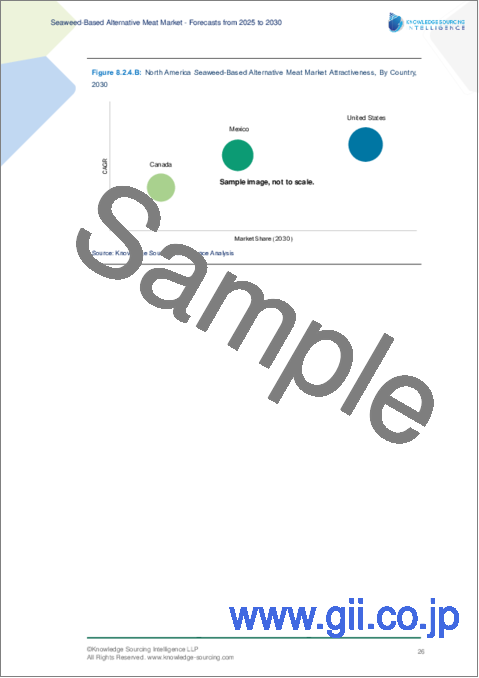|
|
市場調査レポート
商品コード
1604559
海藻ベースの代替食肉の世界市場:2025年~2030年の予測Global Seaweed Based Alternative Meat Market - Forecasts from 2025 to 2030 |
||||||
カスタマイズ可能
|
|||||||
| 海藻ベースの代替食肉の世界市場:2025年~2030年の予測 |
|
出版日: 2024年11月07日
発行: Knowledge Sourcing Intelligence
ページ情報: 英文 125 Pages
納期: 即日から翌営業日
|
全表示
- 概要
- 目次
世界の海藻ベースの代替食肉市場は、2025年の8億8,548万6,000米ドルからCAGR14.62%で増加し、2030年には17億5,150万6,000米ドルに達すると推定されます。
海藻は藻類または海洋植物の一種で、海、川、海などの水域で生育します。肥料や淡水を必要とせず、CO2を大量に吸収し、大量に生産するため、持続可能なタンパク質源です。世界の海藻タンパク質市場も、海藻タンパク質やエキスの利用が増えた結果、急速に拡大しています。海藻には色素、ビタミン、フロロタンニン、多糖類、ペプチド、ミネラル、栄養効果などの生理活性物質が含まれているため、様々な分野で利用されています。
世界人口の増加、植物性食肉への回復力の増加、海藻の健康効果と養殖効率は、海藻ベースの代替食肉市場を押し上げると予測されています。ノルウェー科学技術大学の製品デザイン学科によれば、2030年までに世界人口は98億人になるといいます。新鮮な肉への需要と農地の不足から、利用可能な土地に負担をかけない代替タンパク質の栽培にシフトしていくと予想されます。このため、海藻を含む、土地で栽培されない代替タンパク質源の生産が大幅に増加すると予測されています。さらに、情報源によれば、世界全体で500種以上の海藻が食用に供されています。海藻の消費に関連する健康上の利点、その効率的な生産、投資、研究は、需要を押し上げ、この市場の成長を増加させると予測されています。
世界の海藻ベースの代替食肉市場の促進要因
- 植物ベースの食品市場への投資の増加
世界の海藻ベースの代替食肉市場を押し上げる主要な要因は、植物性の食品市場への投資の増加です。世界の植物性食品、特に植物性肉・魚介類製品のカテゴリーでは、生産技術の開発や味と食感の改善を目的とした多額の投資が行われています。
Goof Food Institute(GFI)は、その報告書の中で、植物性食品分野への世界総投資額は2023年に約85億米ドルに達したと述べています。同機関によれば、植物由来の肉、魚介類、卵、乳製品への投資総額は9億770万米ドルに達し、世界の植物由来食品産業全体の約11%を占めました。
GFIはさらに、様々な国がそれぞれの国で植物性食品市場の需要促進を目的とした新しい政策と規制を導入したと述べました。さらにGFIは、カナダが国内の植物性タンパク質市場を後押しし支援するため、公的資金として約1億1,000万米ドルを投資したと述べました。同様に、英国とドイツ政府も、自国における代替タンパク質の研究開発を成長させるために、主要な政策と投資計画を導入しました。
世界の海藻ベースの代替食肉市場の地理的展望
- 北米が世界の海藻ベースの代替食肉市場の主要シェアを占めると予測されます。
北米地域は、世界の海藻ベースの代替食肉市場において大きな成長を示すと予測されています。北米地域、特に米国、カナダ、メキシコは世界最大の食肉消費国のひとつです。この地域はまた、ベジタリアンとビーガンの総人口が大幅に増加しており、植物ベースの肉製品市場を押し上げると予想されています。Great Green Wallのレポートによると、メキシコは世界で2番目にベジタリアン人口が多く、総人口の約19%がベジタリアンです。同様に、カナダの2023年のベジタリアン人口は約9.4%でした。
本レポートを購入する理由:
- 洞察に満ちた分析:顧客セグメント、政府政策と社会経済要因、消費者選好、産業別、その他のサブセグメントに焦点を当て、主要地域だけでなく新興地域もカバーする詳細な市場考察を得ることができます。
- 競合情勢:世界の主要企業が採用する戦略的作戦を理解し、適切な戦略による市場浸透の可能性を理解することができます。
- 市場促進要因と将来動向:ダイナミックな要因と極めて重要な市場動向、そしてそれらが今後の市場展開をどのように形成していくかを探ります。
- 行動可能な提言:ダイナミックな環境の中で、新たなビジネスストリームと収益を発掘するための戦略的意思決定に洞察を活用します。
- 幅広い利用者に対応:新興企業、研究機関、コンサルタント、中小企業、大企業にとって有益で費用対効果が高いです。
どのような用途で利用されていますか?
業界および市場考察、ビジネスチャンス評価、製品需要予測、市場参入戦略、地理的拡大、設備投資決定、規制の枠組みと影響、新製品開拓、競合の影響
調査範囲
- 2022年から2030年までの過去データ・予測
- 成長機会、課題、サプライチェーン展望、規制枠組み、顧客行動、動向分析
- 競合の市況、戦略、市場シェア分析
- 各国を含むセグメントと地域の収益成長と予測評価
- 企業プロファイル(戦略、製品、財務情報、主要な発展など)
目次
第1章 イントロダクション
- 市場概要
- 市場の定義
- 調査範囲
- 市場セグメンテーション
- 通貨
- 前提条件
- 基準年と予測年のタイムライン
- 利害関係者にとっての主要なメリット
第2章 調査手法
- 調査デザイン
- 調査プロセス
第3章 エグゼクティブサマリー
- 主要な調査結果
第4章 市場力学
- 市場促進要因
- 市場抑制要因
- ポーターのファイブフォース分析
- 業界バリューチェーン分析
- アナリストビュー
第5章 世界の海藻ベースの代替食肉市場:タイプ別
- イントロダクション
- レクチン
- フィコビリプロテイン
第6章 世界の海藻ベースの代替食肉市場:肉タイプ別
- イントロダクション
- 豚肉
- 家禽
- 鶏肉
- その他
第7章 世界の海藻ベースの代替食肉市場:地域別
- イントロダクション
- 北米
- タイプ別
- 肉タイプ別
- 国別
- 南米
- タイプ別
- 肉タイプ別
- 国別
- 欧州
- タイプ別
- 肉タイプ別
- 国別
- 中東・アフリカ
- タイプ別
- 肉タイプ別
- 国別
- アジア太平洋
- タイプ別
- 肉タイプ別
- 国別
第8章 競合環境と分析
- 主要企業と戦略分析
- 市場シェア分析
- 合併、買収、合意、コラボレーション
- 競合ダッシュボード
第9章 企業プロファイル
- Umaro Foods, Inc.
- Algaia
- KIMICA Corporation
- The Seaweed Company
- Yemoja
The global seaweed-based alternative meat market is estimated to attain US$1,751.506 million in 2030, increasing from US$885.486 million in 2025 at a CAGR of 14.62%.
Seaweed is a type of algae or marine plant that grows in bodies of water like oceans, rivers, and seas. It is a sustainable protein source because it doesn't require fertilizers or fresh water, absorbs a lot of CO2, and produces a lot of it. The worldwide seaweed protein market is also expanding rapidly as a result of the increased use of seaweed protein and extracts. Because of the presence of bioactive substances such as colors, vitamins, phlorotannins, polysaccharides, peptides, minerals, and nutritional effects, seaweed is being used in a variety of sectors.
The growing global population, increasing resilience of plant-based meat, and seaweed's health benefits and cultivation efficiency are projected to boost the seaweed-based alternative meat market. As per the Department of Product Design, Norwegian University of Science and Technology, the global population will be 9.8 billion by 2030. The demand for fresh meat and the scarcity of farmland are expected to shift to alternative protein cultivation, which will not strain the available land. This is significantly projected to increase the production of alternative non-land cultivated protein sources, including seaweed. Additionally, as per the source, over 500 seaweed species are available globally for food. The health benefits associated with seaweed consumption, its efficient production, investments, and research are projected to push the demand, increasing this market's growth.
Global seaweed-based alternative meat market drivers
- Increasing investment in the plant-based food products market
A major factor pushing the global seaweed-based alternative meat market is the increasing investments in the plant-based food products market. The global plant-based food products, especially the plant-based meat and seafood products category, witnessed a significant investment aimed at developing production techniques and improving the taste and texture of these products.
The Goof Food Institute, or GFI, in its report, stated that the total global investment in the plant-based food sector reached about US$8.5 billion in 2023. The agency stated that the total investment in plant-based meat, seafood, eggs, and dairy products reached US$907.7 million, which accounted for about 11% of the total plant-based food industry globally.
GFI further stated that various countries have also introduced new policies and regulations aimed at boosting the demand for the plant-based food market in their respective nations. It further noted that Canada invested about US$110 million, for public funding to boost and support the plant-based protein market in the nation. Similarly, the UK and German governments also introduced major policies and investment plans to grow alternative protein research and development in their countries.
Global seaweed-based alternative meat market geographical outlook
- North America is forecasted to hold a major share of the global seaweed-based alternative meat market.
The North American region is forecasted to witness significant growth in the global seaweed-based alternative meat market. The North American region, especially the USA, Canada, and Mexico, are among the biggest meat consumers globally. This region also witnessed significant growth in its total vegetarian and vegan population, which is expected to push the plant-based meat products market. The Great Green Wall organization, in its report, stated that Mexico is home to the second largest vegetarian population in the globe, with about 19% of the total population of the nation being vegetarian. Similarly, Canada's total population of vegetarians was recorded at about 9.4% in 2023.
Reasons for buying this report:-
- Insightful Analysis: Gain detailed market insights covering major as well as emerging geographical regions, focusing on customer segments, government policies and socio-economic factors, consumer preferences, industry verticals, other sub- segments.
- Competitive Landscape: Understand the strategic maneuvers employed by key players globally to understand possible market penetration with the correct strategy.
- Market Drivers & Future Trends: Explore the dynamic factors and pivotal market trends and how they will shape up future market developments.
- Actionable Recommendations: Utilize the insights to exercise strategic decision to uncover new business streams and revenues in a dynamic environment.
- Caters to a Wide Audience: Beneficial and cost-effective for startups, research institutions, consultants, SMEs, and large enterprises.
What do businesses use our reports for?
Industry and Market Insights, Opportunity Assessment, Product Demand Forecasting, Market Entry Strategy, Geographical Expansion, Capital Investment Decisions, Regulatory Framework & Implications, New Product Development, Competitive Intelligence
Report Coverage:
- Historical data & forecasts from 2022 to 2030
- Growth Opportunities, Challenges, Supply Chain Outlook, Regulatory Framework, Customer Behaviour, and Trend Analysis
- Competitive Positioning, Strategies, and Market Share Analysis
- Revenue Growth and Forecast Assessment of segments and regions including countries
- Company Profiling (Strategies, Products, Financial Information, and Key Developments among others)
The global seaweed-based alternative meat market is segmented and analyzed as follows:
By Type
- Lectin
- Phycobiliprotein
By Meat Type
- Pork
- Poultry
- Chicken
- Others
By Geography
- North America
- USA
- Canada
- Mexico
- South America
- Brazil
- Argentina
- Others
- Europe
- Germany
- France
- United Kingdom
- Others
- Middle East and Africa
- Saudi Arabia
- UAE
- Others
- Asia Pacific
- China
- India
- Japan
- South Korea
- Taiwan
- Thailand
- Indonesia
- Others
TABLE OF CONTENTS
1. INTRODUCTION
- 1.1. Market Overview
- 1.2. Market Definition
- 1.3. Scope of the Study
- 1.4. Market Segmentation
- 1.5. Currency
- 1.6. Assumptions
- 1.7. Base and Forecast Years Timeline
- 1.8. Key benefits for the stakeholders
2. RESEARCH METHODOLOGY
- 2.1. Research Design
- 2.2. Research Process
3. EXECUTIVE SUMMARY
- 3.1. Key Findings
4. MARKET DYNAMICS
- 4.1. Market Drivers
- 4.2. Market Restraints
- 4.3. Porter's Five Forces Analysis
- 4.3.1. Bargaining Power of Suppliers
- 4.3.2. Bargaining Power of Buyers
- 4.3.3. The Threat of New Entrants
- 4.3.4. Threat of Substitutes
- 4.3.5. Competitive Rivalry in the Industry
- 4.4. Industry Value Chain Analysis
- 4.5. Analyst View
5. GLOBAL SEAWEED-BASED ALTERNATIVE MEAT MARKET BY TYPE
- 5.1. Introduction
- 5.2. Lectin
- 5.3. Phycobiliprotein
6. GLOBAL SEAWEED-BASED ALTERNATIVE MEAT MARKET BY MEAT TYPE
- 6.1. Introduction
- 6.2. Pork
- 6.3. Poultry
- 6.4. Chicken
- 6.5. Others
7. GLOBAL SEAWEED-BASED ALTERNATIVE MEAT MARKET BY GEOGRAPHY
- 7.1. Introduction
- 7.2. North America
- 7.2.1. By Type
- 7.2.2. By Meat Type
- 7.2.3. By Country
- 7.2.3.1. United States
- 7.2.3.2. Canada
- 7.2.3.3. Others
- 7.3. South America
- 7.3.1. By Type
- 7.3.2. By Meat Type
- 7.3.3. By Country
- 7.3.3.1. Brazil
- 7.3.3.2. Argentina
- 7.3.3.3. Others
- 7.4. Europe
- 7.4.1. By Type
- 7.4.2. By Meat Type
- 7.4.3. By Country
- 7.4.3.1. Germany
- 7.4.3.2. France
- 7.4.3.3. United Kingdom
- 7.4.3.4. Others
- 7.5. Middle East and Africa
- 7.5.1. By Type
- 7.5.2. By Meat Type
- 7.5.3. By Country
- 7.5.3.1. Saudi Arabia
- 7.5.3.2. UAE
- 7.5.3.3. Others
- 7.6. Asia Pacific
- 7.6.1. By Type
- 7.6.2. By Meat Type
- 7.6.3. By Country
- 7.6.3.1. China
- 7.6.3.2. India
- 7.6.3.3. Japan
- 7.6.3.4. South Korea
- 7.6.3.5. Taiwan
- 7.6.3.6. Thailand
- 7.6.3.7. Indonesia
- 7.6.3.8. Others
8. COMPETITIVE ENVIRONMENT AND ANALYSIS
- 8.1. Major Players and Strategy Analysis
- 8.2. Market Share Analysis
- 8.3. Mergers, Acquisitions, Agreements, and Collaborations
- 8.4. Competitive Dashboard
9. COMPANY PROFILES
- 9.1. Umaro Foods, Inc.
- 9.2. Algaia
- 9.3. KIMICA Corporation
- 9.4. The Seaweed Company
- 9.5. Yemoja





